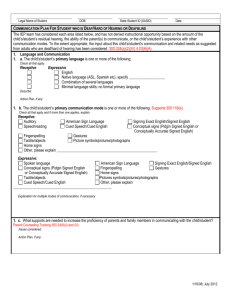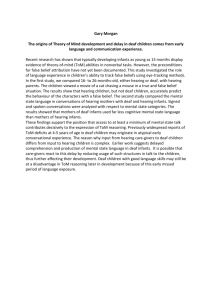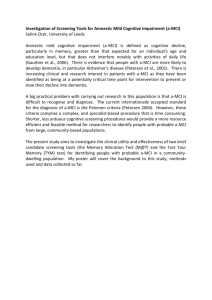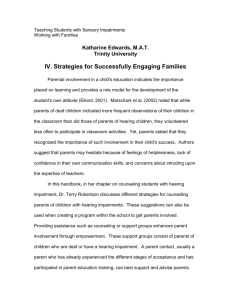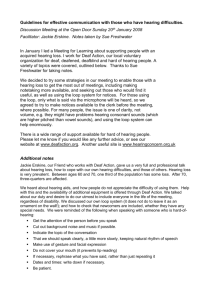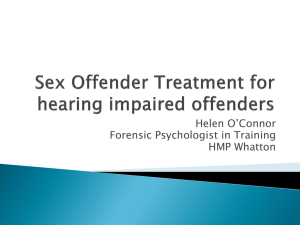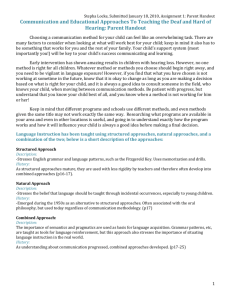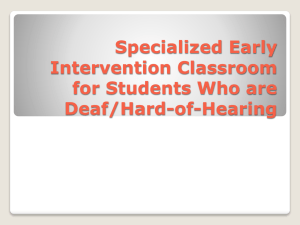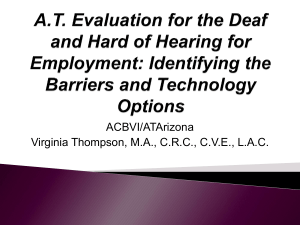PowerPoint 2007 - Play Therapy UK
advertisement
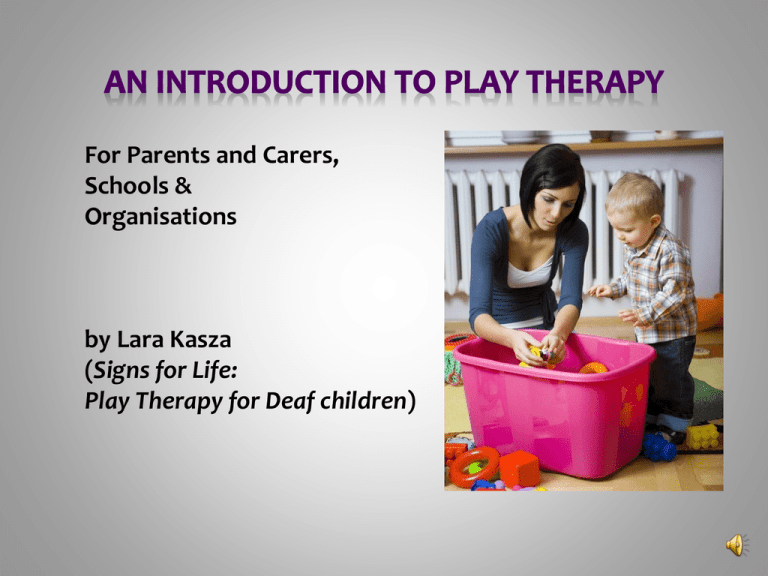
For Parents and Carers, Schools & Organisations by Lara Kasza (Signs for Life: Play Therapy for Deaf children) Contents: Why do we need Play Therapy? How do we know that Play Therapy works? What are the benefits of Play Therapy? Who is Play Therapy for? What is Play Therapy? The Play Therapy ‘Toolkit’ How can we use Play Therapy in your School or Organisation? Safeguards Contacts Why do we need Play Therapy? “OUR GREATEST NATURAL RESOURCE IS THE MINDS OF OUR CHILDREN.” Walt Disney YET of the 34,000 Deaf children in the UK 40% will suffer from a mental health problem compared to 25% of hearing children (www.signcharity.org) How do we know that Play Therapy works? This is a brief behavioural questionnaire commended by OFSTED It measures total difficulties in terms of Emotional symptoms Conduct problems Hyperactivity/inattention Peer relationship problems as well as 5 strengths and pro-social behaviour It is completed by the Referrer (usually the Teacher), the Parent/Carer and the Child before and after therapy. The score shows if there has been any improvement as well as our observation of the child. Teachers have identified the following as contributing to better academic results and more engaged learning: Good participation in group work Communication with others The ability to take in information The ability to concentrate on work They also want: A reduced number of exclusions Improved attendance rates. Do you agree? What would you like to see? 3 2.5 2 1.5 Before 1 After 0.5 0 Group Work Take in Communication Concentration information What do parents hope to see? “An increase in her self-confidence” “Higher self-esteem” “Help him improve his concentration” “To be happy” “To be ok with her friendships going up and down” “To be able to control his emotions – specially his anger” “To be better able to express herself” What would you like to see? You can discuss these with your child’s therapist. What are the benefits of Play Therapy? IT IS OFTEN USED WHEN SIGNING/TALKING THERAPY DOES NOT WORK Who is Play Therapy for? Play Therapy is for children: Who are under performing: academically, socially, culturally or physically or showing signs of delayed development Have behavioural problems Have communication problems Have been traumatised or abused Are affected by bereavement or loss, separated or divorced parents Are withdrawn or aggressive, have been bullied or are bullies Have unauthorised school absences or been excluded Are statemented or on a Child Protection Register and plan Deaf-aware play therapy is tailored for children who are: Profoundly Deaf, either pre or post-lingually, with either hearing or Deaf parents Are deafened, hard of hearing, or have any hearing impairment Are BSL or SSE users Are predominantly oral Have a cochlear implant Hearing children with BSL-using, Deaf parents or siblings. What is Play Therapy? “Play Therapy is a safe and containing therapeutic relationship between a therapist and a child in which the child is free to use a variety of play and creative arts techniques (called the 'Toolkit‘) to work through emotional, behavioural and social problems that are preventing the child from realising their potential.” (PTUK) To sum up it is: A method of helping children with behavioural and emotional problems to help themselves. Play is a natural medium for the child’s self-expression – it is essential for development. Provides an opportunity to ‘play out’ their feelings and problems. It has a therapeutic objective – of bringing a child through a process towards self-responsibility. By providing a free atmosphere within safe boundaries the adult allows the child complete freedom to express themselves physically, verbally and with the play things. It is non-directive, non-interpretative, child-centred and based on Axline’s 8 principles. Warm and friendly relationship Accepts child as is Establishes a feeling of permission Reflects back so the child gains insight Responsibility to make choices is the child’s Child leads – Therapist follows Does not hurry the therapy Only a few limitations so that there is an anchor to reality and the child is aware of responsibilities The Play Therapy ‘Toolkit’: Includes: Sandtray and figurines Doll’s House and cooker Puppets Art and craft materials Clay, play doh and plasticine Board games, activity games Therapeutic storytelling Music Dance & movement Creative visualisations Masks What happens in Play Therapy & how does the Toolkit benefit the different areas of a child’s development? Toolkit: Creative visualisation Storytelling Drama Puppets and Masks Art Music Dance and Movement Sandplay and sandworlds Area developed: Understanding and thinking Moral and Spiritual development Social relationships Caring for self Creativity and aesthetic experiences Communication Physical Emotional How can we use Play Therapy in your School or Organisation? As part of your ethos, commitment and policy of care for the children you support, Play Therapy: Responds to ‘Every Child Matters’ offering children vital extra support to develop their full potential. Can provide the early intervention needed for at-risk children. Compliments your child-centred approach to the education and care of your pupils. Enables children to be more receptive to learning. Demonstrates your commitment to the SEAL(Social and Emotional Aspects of Learning) objectives by addressing your pupil’s social and emotional needs. Addresses the principles of the National Curriculum inclusion statement by responding to pupils’ diverse learning needs Can reduce exclusions and increase school attendance. Fulfils the recommendation of Play Therapy required for some children as part of their Child Protection Plan. The work for Social services is paid by them directly and need not affect the school budget. Requirements needed for safe practice in schools, centres and organisations: Safe play room (consistent) Assurance that sessions will not be interrupted Time for sessions Assessment and post-therapy evaluations using SDQ’s Assured time-tabling Agreed scheduling/advance notification of changes Agreed communication protocols Parental consent Parental involvement Assessment of all children at appropriate stages Integrating Play Therapy with your School or Organisation: Boundaries in the classroom and the playroom are very different Communications between the play therapist and staff will respect child’s confidentiality Need for clear protocols – can share progress but not details of the child’s process Collaborative assessments For play therapy For measurement Safeguarding clinical work: PTUK’s Ethical Framework Clinical Supervision CRB and Insurance Review Sessions with Teacher, Parents and Child Clinical Governance Regular Reporting Pre and Post Outcome Measurements THANK YOU!

